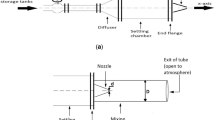Abstract
The flow in a convergent nozzle equipped with chevrons and the flow around the chevrons are numerically simulated and studied on the basis of the numerical integration of the system of Reynolds equations closed by a differential model for the turbulent viscosity. From the calculated results, the flow pattern, the action of the chevrons on the flow, the circulation generated, and the values of the parameters characterizing the streamwise vorticity are determined. The results of calculations of the thrust and flow-rate characteristics of nozzles equipped with chevrons are presented. The data for chevron and conical nozzles are compared.
Similar content being viewed by others
REFERENCES
S. Yu. Krasheninnikov, A. K. Mironov, E. V. Pavlyukov, and V. K. Jitenev, “An investigation of possibility of turbo engine exhaust jet noise reduction using chevron nozzles,” in: Proc. 6th Intern. Symp. “Transport Noise and Vibration”, St. Petersburg, Russia, EAAA Publication (2002), p. 7.
S. Yu. Krasheninnikov and A. K. Mironov, “Effect of the streamwise component of the vorticity formed in a turbulent jet source on the acoustic characteristics of the jet,” Fluid Dynamics, 38, No.5, 698 (2003).
S. Yu. Krasheninnikov and A. K. Mironov, “Turbulent jet acoustic characteristics behavior under additional vorticity creation in jet origin,” in: 10th Intern. Cong. on Sound and Vibration. ICSV10. Stockholm, Sweden, IIAV Publ. (2003), p. 8.
N. H. Saiyed, K. L. Mikkelsen, and J. E. Bridges, “Acoustics and thrust of quiet separate-flow high-bypass-ratio nozzles,” AIAA J., 41, 372 (2003).
A. A. Townsend, The Structure of Turbulent Shear Flow, Cambridge, Cambridge Univ. Press (1956).
V. E. Kozlov, A. N. Sekundov, and I. P. Smirnova, “Models of turbulence for the description of a flow in a jet of compressible gas,” Fluid Dynamics, 21, No.6, 875 (1986).
A. N. Gulyaev, V. E. Kozlov, and A. N. Sekundov, “A universal one-equation model for turbulent viscosity,” Fluid Dynamics, 28, No.4, 485 (1993).
O. V. Gouskov, V. I. Kopchenov, and D. A. Nikiforov, “Flow numerical simulation in the propulsion elements of aviation space system within full Navier-Stokes equations,” in: Proc. Intern. Conf. Methods of Aerophysical Research, Novosibirsk, 1994, Part 1, Novosibirsk (1994), p. 104.
G. N. Abramovich, T. A. Girshovich, S. Yu. Krasheninnikov, A. N. Sekundov, and I. P. Smirnova, Theory of Turbulent Jets [in Russian], Nauka, Moscow (1984).
P. R. Spalart, M. Kh. Strelets, A. K. Travin, and M. L. Shur, “Modeling the turbulent vortex wake behind a high-lift wing,” Fluid Dynamics, 36, No.5, 726 (2001).
Additional information
__________
Translated from Izvestiya Rossiiskoi Academii Nauk, Mekhanika Zhidkosti i Gaza, No. 2, 2005, pp. 76–88.
Original Russian Text Copyright © 2005 by Brailko and Krasheninnikov.
Rights and permissions
About this article
Cite this article
Brailko, I.A., Krasheninnikov, S.Y. Study of the Aerodynamic Characteristics of Chevron Nozzles on the Basis of a Numerical Calculation of the Flowfield. Fluid Dyn 40, 233–244 (2005). https://doi.org/10.1007/s10697-005-0063-y
Received:
Issue Date:
DOI: https://doi.org/10.1007/s10697-005-0063-y




